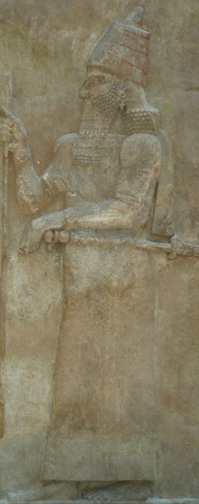Sargon II (721–705 BC)

An image of Sargon II carved on a stone relief from Façade L of the royal palace at Dūr-Šarrukīn (modern Khorsabad). Louvre AO 19873; photo by Karen Radner.
After he had seized the throne of his brother Shalmaneser V by force, Sargon II (Akk. Šarru-(u)kīn, exact meaning disputed) secured his position by punishing 6,300 of his predecessor's supporters and restoring the special exempt status (kidinnūtu) of the cities Aššur and Ḫarrān, whose citizens had come to his aid. Sargon proved himself a worthy Assyrian king, not only through intensive campaigning but also by constructing an entirely new royal city, which he named after himself (Dūr-Šarrukīn, "Fort Sargon"; modern Khorsabad).
Sargon carried out military campaigns from deep into Iran in the east to the border with Egypt in the west, and from the Babylonian marshes in the south to the area of Lake Van in the north. At the beginning of Sargon's reign, Marduk-apla-iddina II (Merodach-baladan of the Bible) seized the throne of Babylon. Sargon attempted to oust him in 720 BC, but was unsuccessful. In 710 BC, Sargon returned and successfully forced Marduk-apla-iddina out of Babylon. At the beginning of the next year, he officially became the king of Babylon by taking the hand of the god Bēl (Marduk) in the akītu-festival. The war, however, was not yet finished. Sargon eventually drove Marduk-apla-iddina from his stronghold Dūr-Yakin and the Chaldean took refuge in the land Elam. After the hostilities had ended, Sargon reinstituted the ancient privileges of several Babylonian cult centers, sponsored large-scale building projects, and reorganized the administration of southern Mesopotamia. To the east and northeast, Sargon defeated local rulers who had sided with the land Urarṭu, re-established Assyrian control over the city Ḫarḫar, whose inhabitants had deposed their pro-Assyrian ruler and allied themselves with the land Ellipi, and thrust deep into Median territory, where he extracted tribute from twenty-eight rulers. In the north, Sargon invaded the kingdom of Urarṭu, one of his chief rivals. He caught its king Rusa I off guard, routed his army, and captured, plundered, and destroyed Muṣaṣir, one of Urarṭu's principal cult centers. Rusa, overcome with grief, is said to have taken his own life, while Sargon held a large public celebration in Aššur, during which a long, poetic account of his deeds was read aloud. Urarṭu's new king refrained from hostile acts against Assyria.
In the northwest, the Phrygian ruler Mita (Midas) incited rulers in Anatolia and along the upper Euphrates River against Assyria. Those who sided with Mita paid the price for their defection; the city Carchemish and the land Tabal were annexed for their involvement in Phrygia's intrigues. The meddlesome Phrygian ruler, however, sued for peace when the Cimmerians began encroaching on his territory. Sargon accepted Mita's offer, thus ending the bitter animosity between the two rulers. In the west, at Qarqar, Sargon defeated the Syrian and Levantine rulers who had rebelled while Assyria had been embroiled in domestic strife. He retook the city Gaza and routed an Egyptian army at the city Raphia. Later, he conquered Ashdod, Gath, and Asdudimmu in Philistia, posted an Assyrian garrison on the border of Egypt, and established friendly relations with Egypt and Cyprus.
In 705 BC, Sargon marched to the troublesome land Tabal to restore Assyrian control. He was killed there in the heat of battle. That inauspicious event and the fact that the Assyrians failed to recover his body had a deep and lasting impact on his successors.
Further reading
G. Frame, "The Tell ʿAcharneh Stela of Sargon II of Assyria," pp. 49-68 in M. Fortin (ed.), Tell 'Acharneh 1998–2004 (Subartu 18). Turnhout, 2006.
G. Frame, "The Inscription of Sargon II at Tang-i Var," Orientalia 68 (1999) pp. 31-57 and pls. I-XVIII.
A. Fuchs, Die Inschriften Sargon II. aus Khorsabad. Gottingen, 1994.
A. Fuchs, Die Annalen des Jahres 711 v. Chr. nach Prismenfragmenten aus Ninive und Assur (State Archives of Assyria Studies 8). Helsinki, 1998.
A. Fuchs, "Sargon II.," pp. 51-61 in M.P. Streck et al. (eds.), Reallexikon der Assyriologie und Vorderasiatischen Archäologie 12/1-2. Berlin, 2009.
A. Kirk Grayson, "Assyria: Tiglath-pileser III to Sargon II (744-705 B.C.)," pp. 86-102 in J. Boardman et al. (eds.), The Cambridge Ancient History, second edition, vol. 3/2. Cambridge, 1991.
K. Radner, "Dur-Šarruken, the 'Fortress of Sargon'," [http://www.ucl.ac.uk/sargon/essentials/cities/durarruken/] Assyrian Empire Builders. London, 2010.
K. Radner, "Sargon II, king of Assyria (721-705 BC)," [http://www.ucl.ac.uk/sargon/essentials/kings/sargonii/] Assyrian Empire Builders. London, 2010.
Jamie Novotny
Jamie Novotny, 'Sargon II (721–705 BC)', The Royal Inscriptions of the Neo-Assyrian Period, The RINAP Project, 2019 [http://oracc.museum.upenn.edu/rinap/neoassyrianhistoryoverview/sargonii721705bc/]